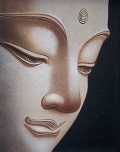- This topic has 3 replies, 3 voices, and was last updated 7 months ago by
Lal.
-
AuthorPosts
-
-
April 8, 2025 at 11:20 pm #54023
lotus
ParticipantIn the explanation of the Purāṇa and Nava Kamma stages, it was stated:
The mind of a puthujjana automatically attaches to the sensory input and generates sankappa with “mano (abhi)saṅkhāra” in the immediate second stage of ajjhatta viññāṇa.
When strong kamma accumulation occurs consciously with speech and bodily actions involving mano, vaci, and kāya (abhi)saṅkhāra. The kammic energy generated in this stage can bring future rebirths (the nava kamma stage).
“Weak kamma accumulation” in the “purāṇa kamma” stage is automatic, and the “strong kamma accumulation” in the “nava kamma” stage happens consciously (while we are aware).
Looking at the chart from the post you recently shared, I still don’t fully understand it.
Does mano saṅkhāra operate in both the purāṇa kamma and nava kamma stages?
Also, if mano saṅkhāra arises consciously, then why is it that the “attachment” to something stops at the vaci saṅkhāra stage rather than at the mano saṅkhāra stage?
-
May 2, 2025 at 7:07 am #54133
dosakkhayo
ParticipantIt seems this thread doesn’t fully address the question, so I’m commenting to bring it to @lal’s attention.
1 user thanked author for this post.
-
May 2, 2025 at 8:11 am #54134
Lal
KeymasterMy apologies! I am not sure how I missed it.
- If there is no response, please don’t hesitate to ask again.
________
1. We have six sense faculties. Those for an Arahant are called “six indriya.” For a puthujjana (average human), they are used with rāga, dosa, or moha in the mind, and they are called “the six āyatana.”
- The six āyatana are usually called cakkhu, sota, ghana, jivhā, kāya, and mano without explicitly referring to them as cakkhu āyatana, mana āyatana, etc.
- For an Arahant, they are cakkhu indirya, mana indriya, etc.
2. Even though a sense event may come through one of the five physical senses, they are always registered in the mind, and the response is via mana āyatana (manāyatana).
- Thus, the responses (saṅkhāra) to any sense input in both purana and nava kamma stages arise in manāyatana. Hence, they are all ‘mano saṅkhāra.’
- However, those mano saṅkhāra in the “purana kamma” stage (without conscious thinking) are very weak, compared to those in the “nava kamma” stage. They are called “saṅkappa.”
- In contrast, those mano saṅkhāra that arise in the “nava kamma” stage, arise in javana citta (consciously), are strong.
3. So, the answer to the question: “Does mano saṅkhāra operate in both the purāṇa kamma and nava kamma stages?” is yes. But they have different strengths.
- Only those in the “nava kamma” stage can bring vipāka in future lives.
- Saṅkappa (weak mano saṅkhāra in the “purana kamma” stage) cannot bring vipāka in future lives.
-
May 4, 2025 at 6:51 am #54154
Lal
KeymasterHere is another way to understand the “purāna kamma” and “nava kamma” stages.
- Free will can operate only in the “nava kamma” stage. In contrast, we don’t have free will in the “purāna kamma” stage.
- This is discussed in “Free Will in Buddhism – Connection to Sankhāra.”
1 user thanked author for this post.
-
-
AuthorPosts
- You must be logged in to reply to this topic.
